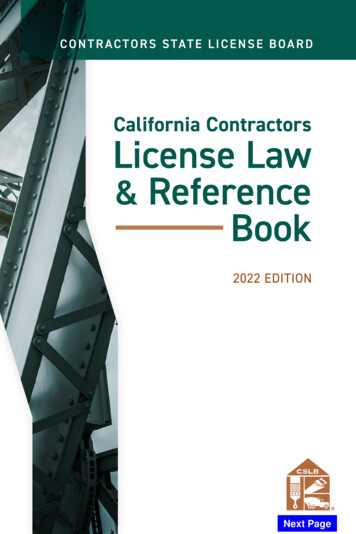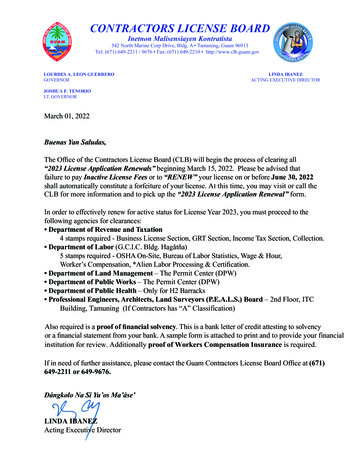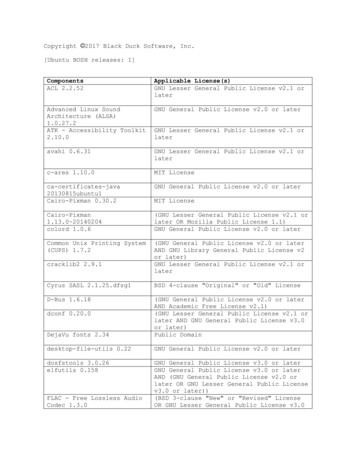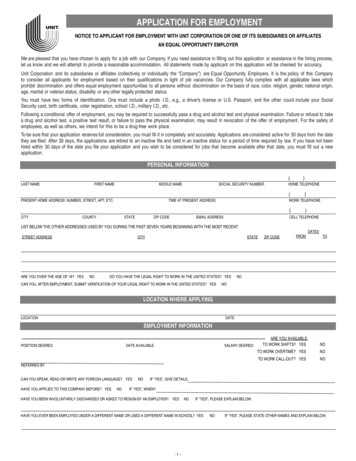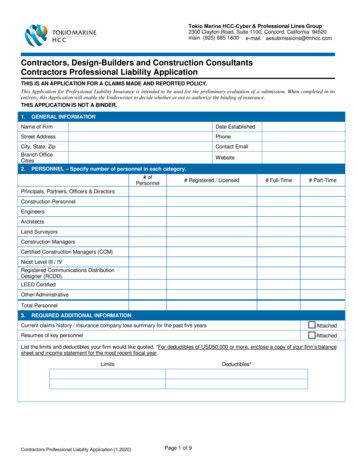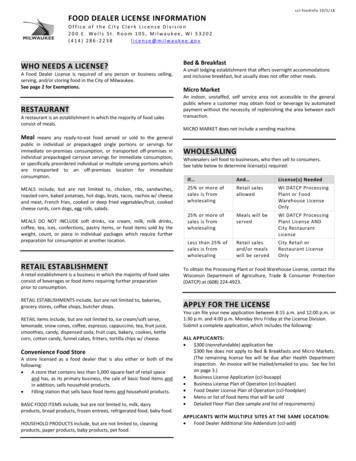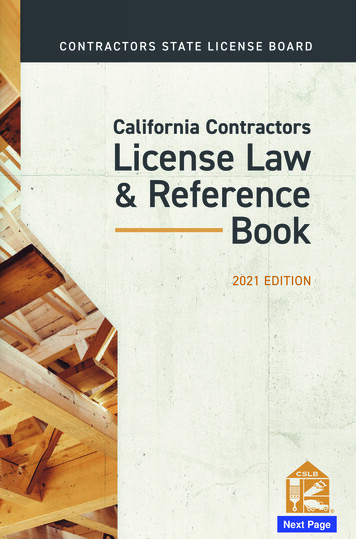
Transcription
CONTRACTORS STATE LICENSE BOARDCalifornia Department of Consumer AffairsA Consumer’s Guide toAsbestos
Members of the Contractors state license boardPaul Schifino, Contractor Member, ChairJoan Hancock, Contractor Member, Vice ChairMark A. Thurman, Contractor Member, SecretaryDavid Dias, Public MemberPastor Herrera Jr., Public MemberMatthew Kelly, Public MemberRobert Lamb, Public MemberEd Lang, Public MemberJames Miller, Public MemberJohn O’Rourke, Public MemberBruce Rust, Public MemberFrank Schetter, Contractor MemberEdmund G. Brown Jr.GovernorAnna M. CaballeroSecretary, State and Consumer Services AgencyDenise BrownDirector, Department of Consumer AffairsStephen P. SandsRegistrar, Contractors State License Board 2013, ContrACtors stAte liCense boArD
A CONSUMER GUIDE TO ASBESTOSTable of ContentsAsbestosIntroduction . 1Warning to do-it-yourselfers . 1What is asbestos? . 2Asbestos and HealthWhy should I be concerned about asbestos? . 3How does exposure to asbestos occur? . 3How will asbestos affect my health? . 4Can medical tests determine whether my exposure to asbestoshas been harmful? . 5Where does exposure to asbestos occur? . 6Asbestos in the HomeVinyl floor tiles and vinyl sheet flooring . 7Patching compounds and textured paint . 7Ceilings. 8Stove insulation . 8Furnace insulation . 9Door gaskets . 9Pipe insulation . 9Wall and ceiling insulation . 10Appliances . 10Roofing, shingles, and siding. 10How will I know asbestos when I see it? . 11General Guidelines for Handling Products Containing AsbestosDisposal. 14Cleaning up . 16Choosing an Asbestos ContractorInsurance and bonding . 18Documentation. 18Resources for Asbestos Information . 21i
AsbestosIntroductionThe California Contractors State License Board (CSLB) licenses and regulates contractorswho are qualified to perform asbestos work in buildings. Additionally, the CaliforniaDepartment of Industrial Relations’ Division of Occupational Safety and Health (Cal/OSHA) registers all contractors who perform asbestos abatement work, and testsand certifies all asbestos consultants. It is illegal for anyone to advertise for asbestosremoval work unless they are state-certified. The contractor license numberand the Cal/OSHA registration number must be included in any advertising.This booklet is designed to inform consumers about how to identify asbestos inbuildings, prevent harmful exposure to the material, and explain the proper stepsto take when contracting with a company to remove asbestos.Warning to do-it-yourselfersAsbestos abatement or removal does not require an asbestos certification if the totalarea involves less than 100 square feet. However, the job is just as risky to perform. Infact, Cal/OSHA regulates all asbestos handling, regardless of the setting. Even smallamounts removed by a homeowner are regulated and must follow strict transportationand disposal requirements.Carefully review the following information so you can make informed decisions to bestprotect your safety and health when handling asbestos. Much of the information coversthe specialized skills and equipment that registered and certified asbestos abatementcontractors are required to use.When you hire a licensed contractor, make sure the individual has all of the appropriateabatement tools, training, licensing, and certification necessary to comply with statelaw so you are not inadvertently exposed to asbestos fibers. If you select to removethe asbestos yourself, be sure to take all necessary precautions and use protectivebreathing equipment.Free information about hiring contractors is available on CSLB’s website,www.cslb.ca.gov, or by calling the toll-free number: 800.321.CSLB (2752). The1
A CONSUMER GUIDE TO ASBESTOSpublications “What You Should Know Before Hiring a Contractor” and “Asbestos: AContractor’s Guide and Open Book Examination” also provide helpful information(See page 21 for additional resources).What is asbestos?Asbestos is a mineral fiber that has been used extensively in the construction andmanufacturing industries, and also can be found occurring naturally in soil. Nearly everybuilding contains some form of asbestos. Its wide use is due to its special heat andchemical-resistant nature and its durability. It has been used in wall insulation; paint;sprayed- or troweled-on surfacing materials; ceiling and flooring materials; pipe, boiler,and duct insulations; cement filler; and a variety of other products.Nearly every building containssome form of asbestos.2C A L I F O R N I A C O N T R A C T O R S S TAT E L I C E N S E B O A R D
Asbestos and HealthWhy should I be concerned about asbestos?Asbestos is classified as a known human carcinogen (cancer-causing-substance) bystate, federal and international agencies. Several types of disease can result fromexposure to asbestos. In fact, inhalation of asbestos fibers can be deadly, althoughit may not become apparent for years after exposure. Even short-term exposure toasbestos can be harmful. For example, family members of asbestos workers havecontracted disease from exposure to asbestos fibers on the workers’ clothing.Authorities believe there is no safe level of exposure, although the higher theexposure to asbestos, the higher the risk of disease.How does exposure to asbestos occur?Asbestos that may be crumbled by hand pressure is called “friable” asbestos. Materialcontaining friable asbestos is hazardous because asbestos fibers are easily releasedinto the air by impact and deterioration.Some asbestos is bound with other materials in products such as roofing shingles orvinyl-asbestos floor tiles. In these products, asbestos fiber is not released as easily.However, fibers in bound asbestos may be released when the material is cut, drilled,scraped, or sanded, or when it is badly deteriorated.Exposure to asbestos occurs when asbestos fibers of various sizes are releasedinto the air and are inhaled. The smaller fibers can remain in the air for long periodsof time. These fibers are so small that they are only visible with a microscope. Infact, it takes 600 asbestos fibers bundled together to equal the thickness of a humanhair. Some of the large fibers may lodge in the nose, but the smaller ones travel throughthe upper airways and become embedded in the lungs. The body has no effectivemechanism for removing these fibers.3
A CONSUMER GUIDE TO ASBESTOSHow will asbestos affect my health?Exposure to asbestos may cause several types of serious diseases, including thefollowing: AsbestosisAsbestosis is a non-cancerous lung disease that occurs when asbestos fibers becomelodged in the lungs, irritating the lung tissues and inflaming the small air tubesand sacs in the lungs. As the inflammation heals, permanent scar tissue (calledfibrosis) remains. The scarring will cause shortness of breath, which grows worseover time, even after exposure ceases. Eventually, it may be impossible for thevictim to inhale enough air, and heart failure may result. What we know about therelationship between exposure to asbestos and asbestosis has been obtainedfrom studies of people who were heavily exposed.Usually, asbestosis is found in people who have been exposed to asbestos over along period of time. The disease is much less likely to occur if proper precautions,such as those described in this booklet, are taken.There is no cure for asbestosis. Lung cancerLung cancer is five times more common in people exposed to asbestos than inindividuals who have not been exposed. Early symptoms are coughing, chest pain,and coughing up blood. Smoking greatly increases the risk of developing lung cancerfrom exposure to asbestos. A smoker who is heavily exposed to asbestos is 30 to90 times more likely to develop lung cancer than a nonsmoker. However, as withasbestosis, proper precautions can help to reduce the risk of contracting asbestosrelated lung cancer. While this disease usually is incurable, if the cancer is detectedearly, it may be surgically treated. MesotheliomaMesothelioma is an extremely rare and deadly form of cancer that is almost alwayscaused by exposure to asbestos. It is truly an “asbestos cancer,” and may resultfrom relatively light exposure to asbestos.This cancer occurs in the lining of the chest and abdomen. Early symptoms areshortness of breath, or pain in the chest or abdomen. Mesothelioma would beexpected to occur in only one out of 100,000 people not exposed to asbestos,4C A L I F O R N I A C O N T R A C T O R S S TAT E L I C E N S E B O A R D
A CONSUMER GUIDE TO ASBESTOSbut one study found that 10 of the 124 deaths of asbestos insulation workers werecaused by mesothelioma. This disease is incurable, and most of the victims diewithin the first year of diagnosis. Other cancersExposure to asbestos also is thought to result in cancers of the esophagus,stomach, colon, rectum, and gastrointestinal tract. These diseases may becaused by the victim swallowing some of the longer asbestos fibers that havebeen caught in the upper air passages. The fibers are then carried to the throatin mucus.The risk of developing these diseasesThe likelihood of developing asbestos-related disease depends on the amountof asbestos to which you are exposed, the length of time, and the number of timesyou are exposed. The greater the total exposure, the greater the chance you willbecome ill.However, many experts believe that there isno safe exposure level. Some shipyard workerswho were exposed to asbestos only a fewweeks during World War II developed asbestosrelated disease in the 1960s. Workers in theconstruction, renovation, and demolition tradeswho encounter asbestos on the job are amongthe higher risk groups. The best way to protectyour health and the health of your family is tolimit exposure as much as possible.The best way toprotect your healthand the health of yourfamily is to limitexposure as muchas possible.Disease usually does not show up for 15 to40 years after exposure.Can medical tests determine whether my exposure toasbestos has been harmful?Anyone frequently exposed to asbestos on the job should see a doctor regularlyto determine whether there are signs of asbestos-related disease and to discussprotective measures. The worker should discuss his or her work history, and the examshould include a complete medical history, a chest X-ray, a lung function test, anda stool sample.5
A CONSUMER GUIDE TO ASBESTOSFor more information concerning the health hazards of asbestos, contact theAmerican Lung Association (See page 23).(See the Resources for Asbestos Information on page 21.)Where does exposure to asbestos occur?Exposure to asbestos can occur in a number of construction- and home improvementrelated operations. Even if a homeowner or contractor is working with less than 100square feet of surface area of asbestos-containing material, exposure may occur.For example: When remodeling a home, if you cut a small ceiling section to add a stairway,room addition, or a porch, you may disturb sprayed-on asbestos insulation; While replacing plumbing pipes during a minor renovation, you may be exposedto deteriorated asbestos-containing pipe covering; or When cutting through asbestos shingle siding to insulate a wall, you may beexposed to insulation fibers.Regardless of the size of the job, check first to determine if asbestos fibers are in theair. Certified asbestos consultants are available to help identify the presence of asbestosand the precautions needed to protect yourself. Their services, including a samplecollection and analysis, may cost around 200.Remember, unless it is explicitly labeled, no one can tell just by looking whether asbestosis present in the material you encounter. If it is, you, your family, and any workers involvedin the job must be protected.The protections and procedures discussed later in this booklet are required by law tohelp protect your health.Exposure to asbestos canoccur in a number ofconstruction- and homeimprovement-relatedoperations.6C A L I F O R N I A C O N T R A C T O R S S TAT E L I C E N S E B O A R D
Asbestos in the HomeAsbestos is used as a building product in many areas of a home. Following aresome examples.Vinyl floor tiles and vinyl sheet flooringAsbestos has been added to some vinyl tiles to strengthen them. It also is present inthe backing of some vinyl sheet flooring and in the adhesives used to place the flooring.While the asbestos is bound into the vinyl or backing, fibers can be released if thetiles are sanded or seriously damaged, if the backing on the sheet flooring is dryscraped or sanded, or if the tiles are severely worn or cut to fit into place.When replacement or repair becomes necessary, follow the guidelines provided onpage 13 of this booklet. Tiles should be handled as little as possible. Avoid sandingor otherwise damaging them. A safe and recommended alternative is to place newflooring material directly over the old tiles or sheet.Patching compounds and textured paintIn 1977, the federal Consumer Product Safety Commission banned patching compoundsthat contain asbestos. Some wall and ceiling joints may be patched with asbestoscontaining material manufactured before 1977. If the material is in good condition, itis best to leave it alone. Sanding and scraping will release asbestos fibers. If it isin poor condition, or if the wall or ceiling needs to be removed or repaired, follow theguidelines on page 13.Some textured paint sold before 1978 contained asbestos. As with patching compounds,textured paint is best left alone if undamaged. You should avoid sanding or cutting atextured paint surface that may contain asbestos.7
A CONSUMER GUIDE TO ASBESTOSCeilingsMany buildings built or remodeled between 1945 and 1978 may contain a crumbly,asbestos-containing material that has been either sprayed or troweled onto the ceilingor walls. If the material is in good condition, it is best to leave it alone. If the materialappears damaged, you may have it tested to see if it contains asbestos. If it does,you can then have it repaired or removed.If possible, contact the builder or contractor who applied the ceiling coating to determinewhether asbestos-containing material was used. This may be difficult to do in olderhomes. If you discover that it contains asbestos and you decide that it is necessaryto remove it, follow the guidelines on page 13. As with other similar tasks dealing withremoval of asbestos, a trained, certified, and registered asbestos abatement andremoval contractor is the professional best equipped to do the job.Stove insulationAsbestos-containing cement sheets, millboard, and paper have been used frequentlyin homes with wood-burning stoves. These asbestos-containing materials are usedas thermal insulation to protect the floor and walls around the stoves. Cement sheetsmay have a label indicating that they contain asbestos.The cement sheet material probably will not release asbestos fibers unless scraped.This sheet material may be coated with a high-temperature paint, which will help sealany asbestos into the material.Asbestos paper or millboard also are used for this type of thermal insulation. Thepossibility of asbestos fibers being released from these materials increases whenthey are placed in areas subject to exposure and wear. Damage or misuse of theinsulating material by sanding, drilling, or sawing also will release asbestos fibers.8C A L I F O R N I A C O N T R A C T O R S S TAT E L I C E N S E B O A R D
A CONSUMER GUIDE TO ASBESTOSFurnace insulationOil, coal, or wood furnaces with asbestos-containing insulation and cement may befound in some older homes. Updating the system to oil, gas, or electricity can resultin removal or damage to the old insulation.If the insulation on or around your furnace is in good condition, it is best to leave italone. If the insulation is in poor condition, or pieces are breaking off, you may wantto consider having it repaired or removed. First find out if the insulation containsasbestos (see page 11); if it does, follow the guidelines on page 13.Door gasketsSome door gaskets in furnaces, ovens, and wood and coal stoves may contain asbestos.The asbestos-containing door gaskets on wood and coal-burning stoves are subjectto wear and can release asbestos fibers under normal-use conditions. Handle theasbestos-containing material as little as possible, following the guidelines on page 13.Pipe insulationHot water and steam pipes in some older homes may be covered with an asbestoscontaining material primarily for reducing heat loss and for protecting nearby surfacesfrom the hot pipes. Pipes also may be wrapped in an asbestos “blanket” or asbestospaper tape. Asbestos-containing insulation also has been used on furnace ducts.Most asbestos pipe insulation in homes is pre-formed to fit around various diameterpipes. This type of asbestos-containing material was manufactured from 1920 to 1972.If you have damaged insulation around pipes or boilers, the best current recommendation is to leave the insulation in place and repair the protective covering. In manycircumstances, this is the best way to minimize potential exposure to asbestos. Forexample, small holes in pipe covering may be filled with caulk or spackle and thencovered with fire-resistant fiberglass cloth or scrim cloth pipe wrap. (These materialsmay not be readily available at most hardware stores.) If the damaged area is easilyaccessible and does not involve a substantial amount of exposure, you may useheat-resistant duct tape to carefully seal the damaged area.9
A CONSUMER GUIDE TO ASBESTOSWall and ceiling insulationHomes constructed between 1930 and 1950 may contain insulation made with asbestos.Insulation that contains asbestos may be found inside the walls or ceiling, “sandwiched” between plaster walls, as well as blown-in or loose-fill insulation. Renovationand home improvements may expose and disturb the materials. In cases of majordisruption of asbestos-containing material, it is especially important to use a trainedasbestos contractor.AppliancesSome appliances are, or have been, manufactured with asbestos-containing parts orcomponents. The Consumer Product Safety Commission tries to identify householdappliances that could release asbestos fibers during use. The commission hasreviewed information on the use of asbestos-containing parts in toasters, popcornpoppers, boilers, slow cookers, dishwashers, refrigerators, ovens, ranges, clothesdryers, and electric blankets. There has been a general decline in the use of asbestosin these appliances in recent years. When asbestos is used, it is in parts that probablywill not result in the release of asbestos fibers during use. It is unlikely that asbestoscomponents in these appliances present a significant health risk from release ofasbestos fibers.Hair dryers with asbestos-containing heat shields are one notable exception. Manufacturers voluntarily recalled such hair dryers in 1979. Laboratory tests of most hair dryersshowed that asbestos fibers were released during use. Current production hair dryermodels do not contain asbestos heat shields.If you are concerned about asbestos in an appliance, do not repair it yourself. Instead,have it repaired by a qualified technician.Roofing, shingles, and sidingSome roofing shingles, siding shingles, and sheets have been manufactured withasbestos, using Portland cement as a binder. Since these products already are placedand outdoors, there is little risk to human health. However, if the siding is worn ordamaged, you may spray-paint it to help seal the fibers.10C A L I F O R N I A C O N T R A C T O R S S TAT E L I C E N S E B O A R D
A CONSUMER GUIDE TO ASBESTOSYou should avoid disturbing these products if they already are part of your home. Unlessroofing must be replaced as a result of normal wear, it is wiser to simply leave itin place.How will I know asbestos when I see it?Before you undertake any project in which you suspect the presence of asbestos, youfirst should try to determine whether the material contains asbestos. Avoid disturbingthe material if at all possible. If you cannot determine from a label, the installer, or themanufacturer whether the material contains asbestos, it is best to assume that theproduct does contain asbestos.People who frequently have worked with asbestos material (such as plumbers, buildingcontractors, and heating contractors) often can make a reasonable preliminary judgmentabout products that contain asbestos, based on a visual inspection. However, propersampling and testing are necessary to confirm the presence of asbestos.In some cases, you may want to have the material analyzed. Such analysis may bedesirable if you have a large area of damaged material or if you are preparing a majorrenovation that will expose material contained behind a wall or other barrier.More than one sample ought to be used to ensure accurate analysis. Use a lab certifiedto perform asbestos analysis that uses state-of-the-art technology, which may includepolarized light microscopy, or the more sensitive transmissible electron microscopy(TEM). You should look for a lab that is able to positively identify collected dustsamples as asbestos. A list of certified test labs can be obtained from the NationalInstitute for Standards and Technology (see page 23 for additional resource information).Proper sampling andtesting are necessary toconfirm the presenceof asbestos.11
Asbestos is a known cancer-causing agent andshould only be removed by a registeredasbestos abatement contractor.
General Guidelines for HandlingProducts Containing AsbestosAsbestos is a known cancer-causing agent and should only be removed by a registeredasbestos abatement contractor.Follow these basic precautions when working with asbestos: Do not disturb any material you think may contain asbestos unless you have to.Removal of the material is usually the last alternative. Seal off the work area from the rest of the building. You may use plastic sheetingand duct tape. Take great care not to track asbestos dust into other areas ofthe residence. Always wear a certified respirator appropriate for the specific asbestos activity.Wear gloves, a hat, and other protective clothing. If possible, dispose of all of thisequipment immediately after using it (see page 14). If you cannot dispose of yourclothing, these work clothes must be washed separately from the family’s wash.The person doing the laundry should be informed about proper procedures toprevent the release of asbestos fibers. When working with asbestos-containing material, wet it with a hand sprayer.The sprayer should provide a fine mist, and the material should be thoroughlydampened, but not dripping wet. Wet fibers do not float in the air as readily asdry fibers and will be easier to clean up. The addition of a small amount (abouta teaspoon to a quart of water) of a low-sudsing dish or laundry detergent willimprove the penetration of the water into the material and reduce the amountof water needed. If you must drill or cut an asbestos-containing material, do the drilling or cuttingoutside, if possible. Wet the material first (according to instructions above). If you must remove the material, avoid breaking it into small pieces. While it iseasier to remove and handle small pieces, you are more likely to release asbestosfibers if the material is broken into small pieces. Pipe insulation was usuallyinstalled in pre-formed blocks; remove these in complete pieces. Refer to the section dealing with Disposal on page 14 of this booklet to learnhow to properly complete the job.13
A CONSUMER GUIDE TO ASBESTOS Please refer to the Asbestos in Construction Standard (Title 8 California Code ofRegulations, section 1529) for specific information on how asbestos-containingbuilding materials must be handled. Visit www.oal.ca.gov for more information.If you think that a material contains asbestos,and you have to handle it, do so very carefully.Special precautions should be taken whileremoving exposed or damaged asbestoscontaining material. If possible, find a contractortrained in safe procedures for handling asbestos(such as a contractor familiar with removal ofasbestos ceilings in schools). Always keep thefollowing precautions in mind:Special precautionsshould be taken whileremoving exposedor damaged asbestoscontaining material. Do not dust, sweep, or vacuum particlessuspected of containing asbestos.This will disturb tiny asbestos fibers and may make them airborne. Fibers are so small that they cannot be seen. If you attempt to use aconventional home or shop vacuum cleaner, you are likely to do moreharm than good. Asbestos fibers are so small that they can pass throughnormal vacuum cleaner filters and be propelled back into the air. Dust should be removed by a wet-mopping procedure or by speciallydesigned “HEPA” vacuum cleaners used by trained asbestos contractors.DisposalUnless otherwise provided for in a contract, the asbestos wastes generated byyou or a contractor performing abatement and removal work are the property ofthe building or home owner. It is the legal responsibility of the owner to properlypackage, transport, and dispose of the wastes without posing any unnecessaryrisk to public health.The California Department of Toxic Substances Control has classified friable asbestoswaste, which is asbestos that can be reduced to a powder or dust with hand pressurewhen dry, as a hazardous waste material.This asbestos waste must be handled and transported in one of the following ways: In sealed, nonreturnable containers (for example, double plastic bags of 6-milthickness, cartons, drums, or cans) from which fibers cannot escape. Waste14C A L I F O R N I A C O N T R A C T O R S S TAT E L I C E N S E B O A R D
A CONSUMER GUIDE TO ASBESTOSwithin the container should be wetted to prevent fibers from blowing into theair in case the container is broken; or In closed vehicles (for example, covered drop boxes or canvas-covered truck boxes)if wastes are too bulky to enclose in sealed containers, and provided the wastesare wetted to prevent blowing dust.Asbestos wastes totaling more than five gallons in volume or more than 50 poundsmust be transported by a registered hazardous waste hauler to an approved treatment, storage, or disposal facility. Persons generating and transporting less than fivegallons or 50 pounds of a hazardous waste to a permitted hazardous waste facilityare exempt from this requirement upon meeting all of the following conditions pursuantto Health and Safety Code section 25163(c). The hazardous wastes are transported in closed containers and packed in amanner that prevents the containers from tipping, spilling, or breaking duringtransporting; Different hazardous waste materials are not mixed within a container duringthe transporting; If the waste is extremely or acutely hazardous, it was not generated in thecourse of any business, and is not more than 2.2 pounds; The person transporting the hazardous waste is the producer of that hazardouswaste, and the person produces no more than 220 lbs. of hazardouswaste in any month; and The person transporting the hazardous waste does not accumulate more thana total of 2,200 lbs. of hazardous waste on-site at any one time.Caution labels are required on containers or drop boxes and must be in conspicuous,legible lettering that spells out the following or equivalent warning: CONTAINS ASBESTOS FIBERS AVOID CREATING DUST BREATHING ASBESTOS DUST MAYCAUSE SERIOUS BODILY HARMThe Department of Transportation does not require you to place cautionary signson transport vehicles.Contact your local health department for information about local landfill facilitiescapable of receiving the asbestos waste.15
A CONSUMER GUIDE TO ASBESTOSCleaning upWetting helps reduce the chance of fibers becoming airborne. After you finish removingthe m
to take when contracting with a company to remove asbestos. Warning to do-it-yourselfers. Asbestos abatement or removal does not require an asbestos certification if the total area involves less than 100 square feet. However, the job is just as risky to perform. In fact, Cal/OSHA regulates all asbestos handling, regardless of the setting. Even .
